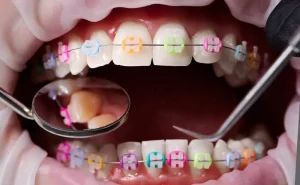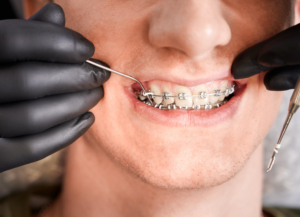Braces are a common and effective way to achieve a straighter, healthier smile. However, getting braces is a big decision that involves understanding the process, the options available, and how to care for them. Braces 101 is your guide to everything you need to know before starting treatment. From understanding how braces work to choosing the right type for your needs, this guide covers it all.
Straightening your teeth is about more than just appearance. It improves dental health, makes cleaning easier, and boosts confidence. By learning about braces ahead of time, you’ll feel confident in the choices you make.
What Are Braces and How Do They Work?
Braces are orthodontic devices designed to correct teeth alignment and bite issues. They consist of small brackets attached to your teeth, connected by wires and sometimes bands. These components work together to gradually shift your teeth into the correct position.
Why Braces Are Important
- They fix issues like overcrowding, gaps, overbites, underbites, and crossbites.
- They improve overall dental health by making it easier to clean your teeth properly.
- They enhance the appearance of your smile and increase self-confidence.
How Braces Work
- The brackets are bonded to the surface of your teeth.
- A wire runs through the brackets and applies gentle pressure over time.
- Regular adjustments tighten the wires, ensuring continuous movement toward alignment.
Each adjustment plays a crucial role in creating a perfect smile. Braces are a step-by-step process, and understanding how they work helps you appreciate the results. Braces 101 covers these basics to ensure you’re informed from the start.
Types of Braces: Choosing the Right Option for You
When it comes to braces, there’s no one-size-fits-all solution. Understanding the different types can help you decide which option aligns with your needs and preferences. Here’s a breakdown of the most common types of braces available today.
Traditional Metal Braces
- Made from high-grade stainless steel.
- Most commonly used and effective for a wide range of dental issues.
- Cost-effective compared to other options.
- Highly durable but more noticeable than alternatives.
Ceramic Braces
- Made from tooth-colored materials, making them less visible.
- A popular choice for adults and teens concerned about appearance.
- Require careful maintenance to avoid staining.
- Slightly more expensive than metal braces.
Invisalign and Clear Aligners
- Clear, removable trays custom-made to fit your teeth.
- Nearly invisible and allow for easier brushing and flossing.
- Ideal for mild to moderate alignment issues.
- Require discipline to wear for the recommended 20–22 hours per day.
Lingual Braces
- Placed on the back side of your teeth, making them hidden from view.
- Aesthetic appeal for individuals who don’t want braces to be visible.
- May take longer to get used to compared to other types.
Comparing Your Options
Each type of braces has its benefits and considerations. Here’s a quick comparison to help you decide:
| Type | Visibility | Comfort | Cost | Maintenance |
|---|---|---|---|---|
| Metal Braces | Noticeable | Moderate | Affordable | Moderate |
| Ceramic Braces | Less visible | Moderate | Higher cost | Requires care |
| Invisalign/Clear | Nearly invisible | High | Varies | Easy |
| Lingual Braces | Hidden | Moderate | High | Requires care |
Choosing the right braces depends on factors like budget, aesthetic preferences, and the complexity of your dental needs. Braces 101 provides this essential knowledge to guide you toward the option that works best for you.
The Process of Getting Braces: What to Expect
Getting braces involves several steps, each designed to ensure effective and personalized treatment. Understanding what happens during this process can help you feel confident about starting your journey.
Initial Consultation
The first step is meeting with an orthodontist to evaluate your teeth and bite. They’ll use X-rays, photographs, and impressions to assess your alignment and create a treatment plan. This is where you’ll learn about the type of braces recommended for your case.
Placement of Braces
Once the treatment plan is finalized, the orthodontist will bond the brackets to your teeth using a special adhesive. A wire is threaded through the brackets and secured with small bands. This process typically takes 1–2 hours and is painless.
Regular Adjustments
You’ll need to visit your orthodontist every 4–6 weeks for adjustments. During these visits:
- The wires may be tightened or replaced to maintain pressure on your teeth.
- Any worn or broken parts will be repaired.
- Your orthodontist will monitor progress and ensure the treatment is on track.
Removal and Retainers
When your teeth are aligned, the braces are removed, revealing your new smile. To maintain the results, you’ll need to wear a retainer as directed by your orthodontist. This prevents teeth from shifting back into their original positions.
Each step in this process is crucial for achieving a perfect smile. Braces 101 ensures you have a clear understanding of what to expect, making the experience more manageable.
Caring for Your Braces: Tips for Success
Proper care is essential to ensure your braces do their job effectively while keeping your teeth and gums healthy. Following these tips can help you avoid complications and stay on track with your treatment.
Maintain Excellent Oral Hygiene
Braces create small spaces where food and plaque can accumulate, increasing the risk of cavities and gum issues. Keep your teeth clean by:
- Brushing after every meal using a soft-bristled toothbrush.
- Using fluoride toothpaste to strengthen enamel.
- Flossing daily with a floss threader or water flosser.
- Rinsing with an antibacterial mouthwash to reduce bacteria.
Avoid Certain Foods
Certain foods can damage braces or make cleaning difficult. Avoid:
- Sticky foods like gum, caramel, or taffy.
- Hard foods like popcorn, nuts, or ice.
- Sugary snacks that increase plaque buildup.
Instead, opt for softer alternatives like yogurt, bananas, or steamed vegetables.
Handle Discomfort and Emergencies
It’s common to feel mild discomfort after adjustments, but it usually subsides within a few days. To manage discomfort:
- Use orthodontic wax to cover irritating brackets or wires.
- Rinse with warm salt water to soothe sore areas.
- Take over-the-counter pain relievers if needed.
If a bracket or wire breaks, contact your orthodontist promptly to prevent delays in your treatment.
Protect Your Braces
- Wear a mouthguard during sports to avoid damage.
- Avoid biting into hard objects like pens or fingernails.
Caring for your braces may take some effort, but it’s worth it for a healthy and beautiful smile. Consistency is key to ensuring your treatment progresses as planned.
FAQs About Braces
Many people have questions before getting braces, especially if it’s their first time. Here are some of the most common questions answered to help you feel more informed.
How long does treatment take?
Treatment duration varies based on the complexity of your case. Most people wear braces for 18 to 24 months, but some treatments may take longer or shorter.
Is getting braces painful?
You may experience some discomfort during the first few days after getting braces or after adjustments. This is normal and usually subsides quickly. Over-the-counter pain relief can help manage any soreness.
What is the cost of braces?
The cost depends on the type of braces and the length of treatment. Traditional metal braces are typically the most affordable, while options like Invisalign or lingual braces may cost more.
Are braces only for kids and teens?
No, braces are for all ages. Many adults get braces to improve their smiles and address dental issues they didn’t fix earlier in life.
Can I still play sports or musical instruments with braces?
Yes, you can. For sports, wearing a mouthguard provides protection. For musical instruments, there may be a short adjustment period, but braces won’t prevent you from playing.
Braces 101 is here to address these common concerns and make the process easier to understand. If you have additional questions, don’t hesitate to reach out to an orthodontist.
The Results: Your Perfect Smile
The journey with braces leads to more than just straight teeth. It provides a foundation for lifelong oral health and a confident smile. Here’s what to expect as you complete your treatment.
Transformations Over Time
Braces gradually move your teeth into their ideal positions, addressing issues like misalignment, overcrowding, and bite problems. Each adjustment brings visible improvements, which can be exciting and motivating.
The Impact of a Straighter Smile
- Health Benefits: Straight teeth are easier to clean, reducing the risk of cavities and gum disease.
- Improved Functionality: Correcting bite issues makes eating and speaking more comfortable.
- Confidence Boost: A well-aligned smile can enhance self-esteem and positively impact social and professional interactions.
Maintaining Your Smile After Braces
Once your braces are removed, your orthodontist will provide a retainer to help keep your teeth in place. Wearing your retainer as instructed is essential for maintaining your results. Regular dental checkups and good oral hygiene habits will also support your new smile.
Braces 101 emphasizes the importance of consistent care during and after treatment to ensure your smile stays as perfect as possible. The journey may take time, but the results are worth it.
Conclusion
Braces are an investment in your dental health and overall confidence. By understanding the process, types of braces, and how to care for them, you’re better equipped to make informed decisions about your treatment. Braces 101 has outlined everything you need to know, from the initial consultation to maintaining your new smile.
The path to a straighter smile may take time, but the results are transformative. Improved oral health, enhanced functionality, and the confidence that comes with a beautiful smile make it all worthwhile. If you’re considering braces, consult an orthodontist to discuss your options and take the first step toward achieving the smile you’ve always wanted.
Achieve Your Best Smile with Orthodontic Excellence
Your journey to a healthier, more confident smile begins with expert care and personalized treatment. At Orthodontic Excellence, Dr. Megha Anand and her skilled team provide high-quality orthodontic solutions, including braces and Invisalign®, to patients of all ages in Newcastle, WA. With a focus on your comfort and satisfaction, we use advanced technology to deliver exceptional results that last a lifetime.
Experience orthodontic care that prioritizes you. Schedule a consultation with us today to explore your options and take the next step toward your ideal smile. Our team is here to support you every step of the way.



